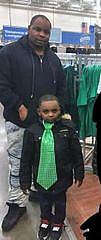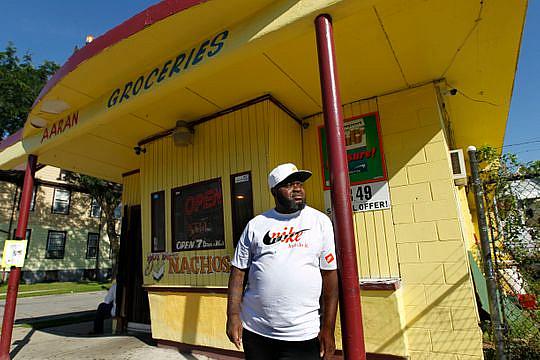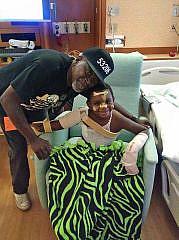While many want to leave Wisconsin's most violent ZIP code, these residents are staying to make it better
James E. Causey’s reporting on this project was completed with the support of a USC Annenberg Center for Health Journalism grant.
Other stories in this series include:
I returned to the 53206 neighborhood — and saw some boys turn into men
Want to get involved in a community garden? It's not all weed-pulling.
How a Milwaukee community garden helped turn a struggling boy into 'Lil Obama'
Milwaukee couple make it their mission to give trauma victims the chance to talk and be heard
A reporter shares lessons from a Milwaukee garden trying to save at-risk boys
In Milwaukee's poorest ZIP code, fruits and vegetables become powerful weapons for saving young boys

Andre Lee Ellis, left, talks with Lisa Huston, right, who escorted her son to the "We Got This" summer program. Ellis was thanking her for supporting and bringing her son to the program. (Angela Peterson/Milwaukee Journal Sentinel)
The first time June Thomas saw a dead body, he was in fifth grade. The body, a man, was in the alley behind his house. He had been shot.
Thomas' father told him to get on to school — the man wasn't doing anything to bother him.
“I thought about that all day at school,” Thomas said.
When he was 16, he saw a woman stab a man with a kitchen knife and run away. The man pulled the knife from his arm, chased the woman down and stabbed her. They both died.
When he was 18, he was at an after-bar party, where a pregnant woman broke up with a guy she was seeing, because her boyfriend was about to get out of jail.
"She told him she didn’t want to deal with him anymore, so he shot her up," said Thomas. "I saw the holes in her side and you could see the baby.
"They both died.”
Thomas, 48, has lived on the 3200 block of North 9th Street most of his life. He operates Aaran Groceries in a small, bright yellow building at the corner of North 11th and West Burleigh streets. It sits in the 53206 ZIP code, the most distressed, impoverished and crime-ridden of the city.
Yet there he stays.
In Milwaukee, therapists, social workers and criminal justice reform officials are focusing new attention on the well-being of those who suffer traumatic experiences as children. They are trying to identify and understand how to build resiliency — the grit and determination needed to survive.
For many, part of the healing process is moving away.
Less attention has been paid to those who grew up in violence and poverty and, decades later, remain. Those for whom the traumas keep coming.
Over the years, Thomas has heard hundreds of gunshots, lost dozens of friends and relatives.
“I’ve seen people get cut up in the face and neck," he said. "Just all over."
Thomas has never seen a counselor. When he was a child, such a concept was unheard of in his neighborhood. These days? Thomas is more worried about the next generation, and spends his free time mentoring African-American boys.
“I’ve seen a lot of bodies and a lot of people hurt," he said. "That stuff stays on your mind. Sometimes I see it in my sleep and sometimes I just think about it.
"It’s hard to explain, but I know it’s not right.”
Many makeshift memorials
In many Milwaukee neighborhoods, makeshift memorials to honor victims of violence — often tied to trees or anchored to the base of streetlights — are a sad fixture of daily life.
Within three blocks of Thomas’ house are three memorials.
Thomas knew all three men.
The first memorial is for his nephew, Marvin Thomas, 37, who was shot and killed after a brief quarrel with another man on Nov. 15, 2011. It features several stuffed animals tied to a tree along with a purple, artificial carnation bouquet.
The second memorial is for Kevin Williams, 32, who was shot the evening of Jan. 29 on North 10th and West Ring streets. He died at the scene. His picture is tied to a tree, a faded sign reading: "In Loving Memory of my Brother."
The third is for Kevin Williams' brother — the one who put up the sign.
Erik Williams poses in the store with his son Erik "Doobie" Williams Jr. Erik Williams was shot and killed Aug. 10, 2018, on the corner of North 10th and West Burleigh streets, while he was walking with Doobie and 1-year-old son Demetrious. Doobie was critically injured after he was shot four times. His father died on the scene and Demetrious was not injured. (Photo: family photo)
Erik Williams, 28, was killed Aug. 12, less than a block away. Witnesses say he was trying to shield his 4-year-old son, who was shot four times but survived. His memorial features teddy bears and a dozen silver, red and blue star-shaped balloons.
As of Dec. 10, of the 94 killings in Milwaukee: 83 percent of the victims were shot; 76 percent were black; 72 percent were between the ages of 18 and 39; and 78 percent of the victims were men, a Milwaukee Journal Sentinel analysis found.
Though total homicides are down from 139 in 2016 and 118 in 2017, the city's homicide rate this year is running at about 11.6 per 100,000 people. That's on pace with Chicago, which has drawn national headlines for its gun violence.
Just hours after Erik Williams was killed, Thomas was sitting behind Plexiglas at his store. As customers came and went, he tried to process it all.
“Erik was a good friend of mine," he told one. "He was a good father. He didn’t mess with anybody.”
He paused.
“For them to just open fire on a crowd like that and hurt Doobie, too?" he said, referring to Erik's son. "That don’t make any sense. Doobie is only 5 years old. He lost his daddy and almost lost his life.”
June Thomas, 48, stands in front Aaran Groceries, where he is a partner in the business. Thomas is no stranger to violence. "I've seen a lot of bodies and a lot of people hurt. That stuff stays on your mind," he said. (Photo: Angela Peterson/Milwaukee Journal Sentinel)
Hours after the police tape had come down, customers flowed in and out of the store, some buying chips and soda, many offering Thomas condolences. A smaller group gossiped about what they heard happened.
One woman, who came in to buy cigarettes, motioned for Thomas to come from behind the counter. She gave him a hug and told him the shooters were just jealous of Williams.
Bit by bit, more details come out.
Just an hour before the shooting, Williams was at Thomas' house. The two friends had planned to catch up over a few steaks Thomas had put on the grill.
“Then he got a call and told me that he had to go pick up Doobie,” Thomas said. “He didn’t even get a chance to eat, but he told me that he was going to come right back.”
The two were regular volunteers at a nearby community garden, where each Saturday morning during the summer, dozens of African-American boys participate in the "We Got This" mentoring program.
Thomas said the two had been talking about how the neighborhood was improving.
A customer told Thomas that nowhere is safe anymore. Thomas shook his head in sadness.
When he heard about the shooting, Thomas quickly drove to the scene.
“I jumped in my car and drove down there. Erik was just lying in a pool of blood, face down, and they were putting Doobie in an ambulance.
"I stayed there until the coroner took his body away.”
Thomas told a customer how once, in the summer of 2016, he was at Little Caesars Pizza on North 92nd Street and West Capitol Drive when he suddenly felt ill and started coughing up blood. Thomas has high blood pressure and is on dialysis, and couldn’t breathe.
Williams, who was there, rushed him to the Ascension St. Joseph Hospital emergency room on North 51st and West Burleigh streets.
“He saved me and I wasn’t there for him," Thomas said. "This is going to haunt me forever."
One man assured Thomas there was nothing he could have done.
"If you were there, it could've been two dead men instead of one," he said.
Erik "Doobie" Williams Jr. and Andre Lee Ellis take a picture in the hospital after the 4-year-old came out of a coma after he was was shot four times near North 10th and West Burleigh streets on Aug. 10. (Photo: Photo courtesy of Andre Lee Ellis)
Impact echoes through generations
Studies have shown the impact of living a lifetime in trauma is similar to that of soldiers who have experienced combat.
What's more, the impact can echo through the generations.
According to the latest figures: Two-thirds of the children in the city's 53206 ZIP code live in poverty; of the 29,000 residents, 45 percent live below the poverty line ($25,100 for a family of four); and 66 percent of the homes are headed by black women.
“Poverty and trauma are directly connected, and we can’t talk about one without talking about the other,” said Reggie Jackson, head griot, or storyteller, at America’s Black Holocaust Museum. Jackson studies disadvantaged communities and uses that information to hold community discussions.
Reggie Moore, who manages the City of Milwaukee Office of Violence Prevention, said the city's 19 homicides in August — the month Erik Williams died — is one measure of how much work needs to be done.
In one case, Robert Taylor, 41, was shot and killed and two others were injured Aug. 9 at a Citgo gas station at North 27th Street and West Capitol Drive. Taylor was a father of five children.
"What people don't understand is the impact a death leaves on a family, on children and a community," Moore said. "His children will grow up without a father, and the impact of his death will impact his family for years and maybe even decades."
Police said the shooting was the result of a two-year feud over a "relationship issue" — the sort of dispute that builds up over time, before exploding. Such cases seem to be increasingly common, Moore said.
Moore said his office is working on a “conflict resolution strategy” to train community residents to be peacekeepers.
“We want people to know that if they see something brewing online, or in their community, to intervene before it escalates to the point of violence," he said. "If they need help, they can reach out to our conflict mediation people who can help.”
Thomas sees the problems as even deeper.
He traces them to the loss of jobs when factories moved out of the central city — Milwaukee County lost 47 percent of its manufacturing jobs from 1978 to 2000. That was compounded by tighter restrictions on receiving welfare.
Thomas said receiving public assistance in his 20s helped him, and others, through some lean times. When eligibility rules were changed, he said, the safety net was cut for many families.
“That’s when things really started to go bad,” Thomas said. “When people don’t have nothing, they start to prey on each other.”
That led to violence and — often — prison.
Wisconsin has the highest black male incarceration rate in the nation and a 2013 University of Wisconsin-Milwaukee study found that was driven by 53206, with a majority of its men having spent time in jail or prison.
Thomas said people in his neighborhood are stuck: They are stressed out from being poor and exposed to violence. They drink or get high to deal with the stress. Most companies require drug tests, which prevent many from getting a job. So they turn to crime, victimizing a new generation.
“You can’t win.”
Support closer to home
While social service and education communities are working the hardest to address the legacy of trauma, Thomas has found — and offered — more support closer to home.
Andre Lee Ellis, who moved into the neighborhood in November 2011, just days before Thomas' nephew, Marvin, was killed, heard the gunshots that took Marvin's life.
Ellis had just walked into his duplex on North 9th Street from the corner store when six gunshots rang out. At first, he thought he may have been shot.
When Ellis went outside he saw Marvin Thomas laying in the middle of the street.
The killing inspired Ellis to acquire a vacant lot on the corner and create a community garden. Three years later, in 2014, he started the "We Got This" mentoring program aimed at black boys, ages 12 to 17.
Boys from the "We Got This" summer program pick up trash near a memorial for Marvin Thomas, whose death sparked the "We Got This program at North 9th and West Ring Street. (Photo: Angela Peterson/Milwaukee Journal Sentinel)
June Thomas said at one time his nephew was in the streets "hustling," but had turned his life over to Islam. He said his nephew was ambushed by an armed gunman, while he was talking to someone on the street.
“He could have run in his house, but he had his auntie and other relatives in the house and he didn’t want them hurting his family, so he took off running down the street," Thomas said. "They shot him in his leg first and then they shot him in the side.
"And then a head shot."
When Thomas thought about revenge, it was Ellis — an actor-turned-activist — who helped calm him down.
The two repeated Ellis' mantra together:
"We got this."
"We got this."
"We got this."
Four years later, no one has been charged in the killing.
Sometimes Thomas just goes to the community garden to sit on a bench and pray.
“I can come here if I've got a lot on my mind," he said. "I can release a lot of stuff."
Memorable mentor
June Thomas was a fixture during the summer mentorship program.
Among the mentors, Thomas stood out — strong arms, covered with tattoos. A loud, booming voice when he yelled.
“You know, if you hang out with me, I don’t want no back talk or I’m sending you home," he said to a group of boys one day early on. "Andre is nice, but I don’t play.”
As Thomas’ group cleaned up several blocks around the garden, he told the boys his expectations.
“You have to wash up before you come to the garden," he said. "You just can’t roll out of bed and come here. I bet you some of you didn’t even brush your teeth this morning.”
Some of the kids laughed and teased one another.
“I hear some of your mouths," he said later. "All that cursing is a turnoff for anybody. What girl is going to want to be around you with a mouth like that.”
Moore, the head of the city's violence prevention office, said it's important to focus on people like Thomas and Ellis — to focus on "healing the healers."
“They are on the front lines every day loving the community and serving the community, but they are witnessing and losing people they care about,” Moore said.
Since the shooting of Erik Williams, Thomas has had trouble sleeping. He mostly just catnaps.
“When I saw all that blood it just reminded me of all the other stuff that I’ve seen in my lifetime that I try to forget," he said. "But you can’t forget about it because when you close your eyes, sometimes you just see bodies, bodies, bodies.”
He is torn. His wife, Mechelle, wants them to move. But his store is there along with family and lifelong friends. Besides, where would they move?
“I told her that it’s not just this area," he said. "Our entire community is traumatized.”
How to get help
To better help people in crisis situations, all 600 Milwaukee firefighters and EMTs have received training from the Milwaukee County Behavioral Health Division, said Reggie Moore, head of the city's Office of Violence Prevention.
For help, call (414) 257-7621 or go to http://wraparoundmke.com/programs/mutt/
Within 48 hours of a referral being made, the mobile crisis team reaches out to the family, Moore said. The unit has assisted 600 families in three years.
Read the series
Go here for other stories in the "Cultivating a Community" series by reporter James E. Causey , as well as videos and photo galleries and photojournalist Angela Peterson.
Community discussion/photo exhibit opening reception
Photos by the Milwaukee Journal Sentinel's Angela Peterson from this project will be on display at the Black Historical Society/Museum, 2620 W. Center St. until the end of the year. In 2019, the photos will be displayed at other community locations.
Join us on Friday, Dec. 14, from 5:30 p.m. to 7:30 p.m., for an opening reception that will feature brief talks from Peterson and reporter James E. Causey, as well as Andre Lee Ellis and others. Admission is free. RSVP at www.jsonline.com/gardenevent.
[This story was originally published by Journal Sentinel.]

